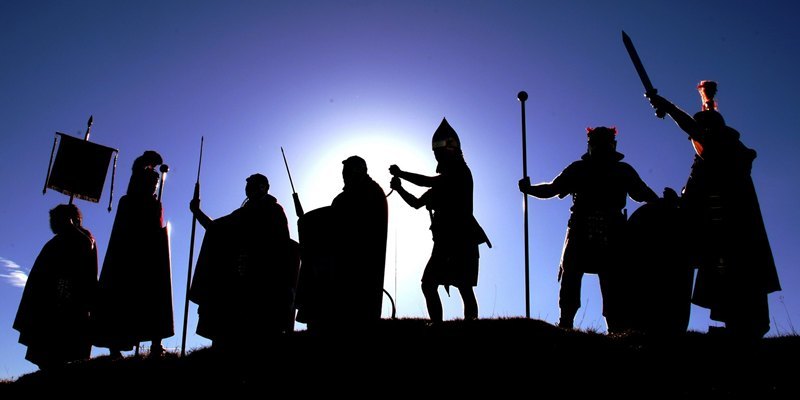Perthshire has been hailed as the perfect location for a new world heritage site capable of attracting thousands of new visitors.
The case for the creation of a National Roman Centre that would promote and protect the country’s Roman heritage was set out by Mid Scotland and Fife MSP Murdo Fraser.
He was joined amid the remains of Ardoch Fort part of the Gask Ridge frontier by members of the living history re-enactment society the Antonine Guard, as he called for the backing of the Scottish Government.
A short document entitled Perthshire’s Roman Past details the many locations with Roman links and presses the government to help make the centre a reality.
The Romans ruled Britain for almost 400 years (43-410 AD), and during much of the period the frontier was Hadrian’s Wall. However, there were at least three occasions on which Roman armies moved into Scotland in force and occupied what is now Perth and Kinross.
The area is home to the most northerly frontier of the Empire, the Gask Ridge, which stretched from the Highland massif through Fife and Perthshire. Originally a series of timber and turf-built forts and signal stations, it is significant not just in Romano-Scottish history but also in the timeline of the history of Roman land frontiers across the empire.
Evidence of the Gask Ridge and of the Romans’ occupation of Scotland is still to be found throughout the area and some of the sites remain among the finest in Europe.
It is hoped that the development of a National Roman Centre would help to preserve these sites, as a number are being undermined by time and, in the case of Ardoch, rabbits, which have been burrowing around the fort unchecked for years.
However, while there are centres that celebrate both Pictish and Viking history there is nothing that celebrates the rich, diverse Roman history of Scotland.
Mr Fraser believes more needs to be done and he’s convinced that the creation of a national centre is what’s required to promote the history of the region, protect its Roman sites and, eventually, to attract thousands of new visitors.
“We must ensure that our Roman sites that are maintained by Historic Scotland and by private owners across Scotland are preserved for future generations,” Mr Fraser said. “I want the Scottish Government to do more to promote Roman history and I believe that there is an opportunity to create a National Roman Centre in Perthshire.
“If we have a National Roman Centre, then we could eventually have thousands of people coming to Scotland to visit our ancient Roman sites. Furthermore, it could be used as a base for our youngsters to learn about the country’s Roman history.”
Mr Fraser added, “There are so many Roman sites across Perthshire, including Ardoch Fort and Inchtuthil Fort, as well as the Muir o’ Fauld and Ardunie watch towers.
“There is Blackhill, part of the defences of two Roman marching camps, probably dating to the early third century and there are also other forts, such as Cardean Fort and Fendoch Fort in Perthshire. The impact and contribution of the Romans coming to Scotland hundreds of years ago cannot be overstated and with this depth and richness in Roman history, I believe that Perthshire would make an ideal site for a National Roman Centre.”
Important Roman sites in Perthshire include:
Ardoch Fort part of the Gask Ridge frontier, the site (to the north east of Braco) saw use during each of the occupations. In 1726 Alexander Gordon wrote, “This Fort at Ardoch I recommend to the Publik as the most entire and best preserved of any Roman antiquity of that kind in Britain.” It remains one of the best preserved Roman forts in Scotland and although there are no visible buildings, the defensive earthworks remain impressive. Ardunie the site of a Roman watch tower, one of a series running between Ardoch and the Tay, along the Gask Ridge, and dating to the first century. Bertha another of the Gask Ridge forts. Remains are still visible in Perth. Blackhill Woods to the north of Ardoch Fort. The site features parts of the defences of two Roman marching camps, probably dating to the early third century. Cardean a fort. Carpow situated near Newburgh on the Tay Estuary, this was home to a 30-acre Roman fort big enough to hold half a legion (a legion was around 5000 men). It had a quay to allow supplies to be brought to what was then Caledonia by sea. Fendoch a fort at the mouth of the Sma’ Glen. It featured a watchtower to give early warning of attack from the glens. Inchtuthil the huge legionary fortress was the Romans’ largest ever base in Scotland and overlooked the north bank of the River Tay, southwest of Blairgowrie. The fort formed a strategic focal point of the Gask Ridge complex and was built to house an entire Roman legion. It was designed as a springboard for future expansion into the Highlands but was never fully completed as forces were withdrawn from Britain to help protect the Danube frontier. Muir o’ Fauld the site of a first century Roman watch tower from the Gask Ridge Complex was initially in dense forest. Now cleared, the site has survived remarkably well. Strageath a Gask Ridge fort and temporary camp.
